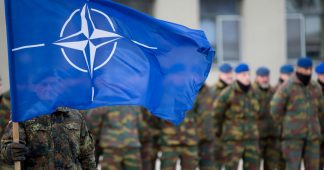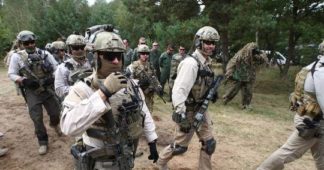US announces plans to flood Europe with troops and weapons
By Andre Damon
Jun 30, 2022
In remarks at the NATO Summit in Madrid, Spain, US President Joe Biden announced a sweeping increase in US troop deployments to Europe as part of a plan by NATO to militarize the continent for its ongoing war with Russia and escalating conflict with China.
The NATO summit formally invited Sweden and Finland to join the alliance, effectively doubling NATO’s land border with Russia and consummating the military alliance’s decades-long eastward expansion.
Speaking Wednesday, Biden praised the decision of the governments of Sweden and Finland to “move away from neutrality and the tradition of neutrality.”
Biden announced that the US would send another 20,000 troops to Europe, bringing its total deployment there to 100,000.
He pledged to increase the number of US Navy destroyers stationed in Spain’s Naval Station Rota to six.
He also announced the formation of a permanent US military headquarters in Poland, marking an unprecedented US military inroad into a former Warsaw Pact country.
He also announced an additional “rotational brigade” of 5,000 personnel headquartered in Romania, as well as sending two additional F-35 fighter squadrons to the UK and the stationing of additional air defense systems in Germany and Italy.
Biden declared: “NATO is ready to meet threats from all directions, across every domain: land, air and the sea.”
The announcement is the largest military expansion in Europe in decades, the Wall Street Journal commented.
Critically, the summit announced the publication of a new NATO “strategic concept,” defining Russia as the “most significant and direct threat to the allies’ security.” Russia was previously classified as a “strategic partner” in NATO’s 2010 strategy document.
For the first time, the NATO strategic concept also targeted China, declaring that it posed a “challenge” to the alliance.
Individual NATO members pledged unlimited support to the war effort, with German Chancellor Olaf Scholz declaring that Germany would continue to arm Ukraine “intensively—for as long as it is necessary to enable Ukraine to defend itself.”
Significantly, the leaders of Japan, South Korea, Australia and New Zealand joined the summit, leading Foreign Affairs to comment that “battle lines are being drawn that could last for generations.”
The UK is expected to expand its troops stationed in Estonia from 1,000 to 1,700.
The Guardian noted, “In total, eight frontline Nato battlegroups stretching from Estonia to Bulgaria, once designed to act as small initial defence force, are expected to be increased in size to a brigade level of 3,000 to 5,000 troops.”
The overwhelming response in the US media and political establishment to Biden’s further commitment of blood and treasure to the war effort was enthusiastic support.
Hailing NATO’s plans to expand its fighting forces seven-fold, the Washington Post declared that if “Ukraine’s steadfast resistance and the West’s firm stance” continue, “success will follow.”
The New York Times, for its part, praised the would-be dictator Donald Trump’s calls for the expansion of US military spending, declaring in an editorial that Trump “wasn’t wrong” to call for Europe to spend more on its military. The Times concluded, “In this fateful moment, NATO must take a serious look not only at deterring Russia but also at itself, its purpose and its readiness to really share that burden.”
The NATO summit also marked a significant shift in the use of the war in Ukraine to more aggressively target China. On Wednesday, the White House added five Chinese companies to a blacklist for allegedly helping the Russian war effort.
The Commerce department claimed that the companies “continue to contract to supply Russian entity listed and sanctioned parties.”
Warning that this was only the beginning, Under Secretary of Commerce for Industry and Security Alan Estevez said, “Today’s action sends a powerful message to entities and individuals across the globe that if they seek to support Russia, the United States will cut them off as well.”
In a critical admission, NATO Secretary-General Jens Stoltenberg acknowledged that NATO had been expanding its forces in preparation for conflict with Russia for years, declaring, “The reality is also that we have been preparing for this since 2014. … That is the reason that we have increased our presence in the eastern part of the alliance, why NATO allies have started to invest more in defense, and why we have increased [our] readiness.”
Indeed, NATO’s European members along with Canada have increased military spending by between 1 percent and 6 percent every year since the 2014 US-backed coup in Kiev.
Five months after the outbreak of the war in Ukraine, the central war aims of the US and NATO are emerging clearly. In an interview with CNN over the weekend, moderator Jake Tapper asked Secretary of State Antony Blinken whether Russia was “taking over” significant sections of the country.
In response, Blinken downplayed the significance of Ukraine losing whole swaths of its territory, declaring, “let’s not confuse the tactical with strategic.”
He added, “[w]hat’s really important is the strategic proposition that Putin will not succeed in what he’s tried to achieve. … He’s also tried to divide NATO. We’re about to go to a NATO summit, where the alliance is going to show greater unity, greater strength than in my memory.”
In other words, the “strategic” goal of the United States in provoking Russia to invade Ukraine was to create the conditions for a massive rearmament of Europe, under American aegis.
The immediate targets of this rearmament will be Russia and China, but the massive land forces being mobilized will be used no less at home than abroad.
We remind our readers that publication of articles on our site does not mean that we agree with what is written. Our policy is to publish anything which we consider of interest, so as to assist our readers in forming their opinions. Sometimes we even publish articles with which we totally disagree, since we believe it is important for our readers to be informed on as wide a spectrum of views as possible.











